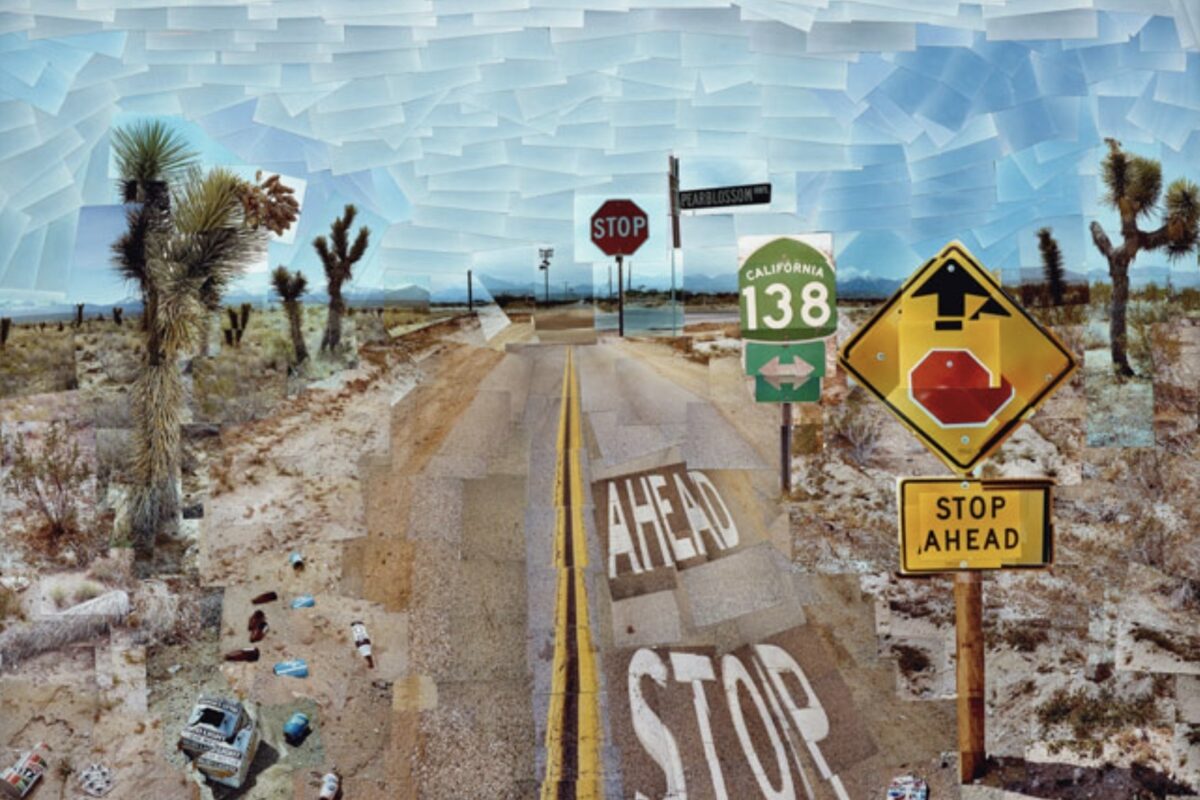Bridget Riley rose to prominence in London in the 1960s with her bold vision for a new language of painting based upon repeated geometric forms. Since then, she has become one of the leading artists of her generation. We are delighted to have some new works by the artist in the gallery, so here are 5 things you may not know about her and her groundbreaking work.
No painter, dead or alive, has ever made us more aware of our eyes than Bridget Riley.
Robert Melville, 1971

Bridget Riley's drawings and sketches hanging in her studio
1. Bridget Riley was the “It” girl of the 1960s. Riley held another wildly popular exhibition that same year, in the US, at the Richard Feigen Gallery in New York. The show, an exhibition of 16 paintings, was a sell-out success, selling out before it even officially opened. Maurice de Sausmarez, painter and friend of Bridget Riley’s, describes the furore that surrounded the artist: ‘On the opening day at Feigen’s gallery all sixteen works on exhibition were sold and a waiting list compiled of collectors anxious to have one of her works.’In 1999, the Serpentine Gallery exhibited her 1960s and 1970s pictures attracting 130,000 visitors, the highest attendance for a show at Serpentine.

Stretch by Bridget Riley, 1964
2. She has several important firsts.Bridget Riley was the first woman to receive the Sikkens Prize, a prestigious Dutch art award that recognises the use of colour. The Sikkens Foundation has described Riley’s work as pure, subtle, and precise as well as a ‘sensational oeuvre from which a new generation of artists is drawing inspiration.’ In 1968, though she was reluctant to be known as a female artist but rather as an abstract painter, she was the first woman to win the International Prize for Painting at the Venice Biennale.

Intervals 1 & 2 by Bridget Riley, 2019
3. Riley is one of the top ten most expensive living British artists and one of the top ten most expensive living women artists. Her paintings have increased 25,500% in value in the last 25 years. Chant 2 (1967), part of the trio shown in the Venice Biennale, went to a private American collector for $5.1 million, in July 2008, at Sotheby’s. This piece was the artist’s first work exclusively in colour after years spent experimenting in black and white. In 2006, her Untitled (Diagonal Curve) (1966), a black-and-white canvas of dizzying curves, was bought by Jeffrey Deitch at Sotheby’s for $2.2 million, nearly three times its $730,000 high estimate and also a record for the artist.

Cataract 3 by Bridget Riley, 1967
4. She believed that art is a social act, which led her to start SPACE in 1968 with her husband, Peter Sedgely. , which she has been running for forty years.Standing for Space Provision Artistic Cultural and Educational, SPACE was an attempt to build a utopia for artists and is now the oldest continuously operating artist studio organisation in London.After 40 years SPACE is still going strong, forming a creative community of artists.providing studios to over 700 artists across the city, SPACE operates a recognised exhibition programme, international residencies and a community-facing learning and participation platform.

Bridget Riley working in her London studio, 1980
Photographed by Bill Warhurst
5. In 1966 Keith Moon, drummer of the The Who, was photographed wearing a T-shirt adorned with Riley’s painting Blaze. Copied freely by graphic designers and fashion magazines, Bridget Riley was upset by the commercialisation of Op Art. In 1965, Riley’s exhibition The Responsive Eye, curated by William C. Seitz, was shown at the Museum of Modern Art in New York, which drew worldwide attention to her work and the Op Art movement. Her art was repeated and reproduced by ready-to-wear manufacturers, her paintings commodified without her having a say. Riley is noted as saying that her “heart sank” as she drove from the airport down Madison Avenue, seeing shops littered with dresses based on her paintings. She denounced the way her art was being “vulgarised in the rag trade” and discovered that in the US there was no copyright to protect the work of artists. It was not until 1967 that a US copyright legislation was passed following an independent initiative by New York artists.

Rose Horizontal by Bridget Riley, 2018
To view available works by the trail-blazing artist that is Bridget Riley, click here or visit our online viewing room below. Don't hesitate to get in touch should you have any questions or wish to arrange a viewing.
More editorials about Bridget Riley
Art Market
The Hang | Your monthly round up of Art Market based News
31 Jul 2025 | 4 min read

Art Market
Market Watch: Auction highlights | RESULTS Part 2
7 Mar 2025 | 2 min read

Art Market
Market Watch: Auction highlights | RESULTS
3 Mar 2025 | 2 min read

Art Market
Market Watch: Auction highlights | Part 2
1 Mar 2025 | 2 min read

Art Market
Market Watch: Auction highlights | Part 1
24 Feb 2025 | 2 min read

Art Market
12 Moments of 2024
30 Dec 2024
Artists
All Things Bright and Beautiful
10 May 2023 | 3 min read
Artists
A Brief Retrospective of Bridget Riley
28 Mar 2023 | 5 min read
Art Market
Art Market Insight | What, Why and How To Invest
19 Jul 2022
More from Artists
Artists
Happy Birthday Andy Warhol, The King of Pop Art
6 Aug 2025

Artists
The Psychology of Kusama
14 Jul 2025 | 3 min read

Artists
From Rothko to Ruscha: Unpacking Harland Miller’s Influences
10 Jul 2025 | 3 min read

Artists
Decoded: David Shrigley
8 Jul 2025 | 2 min read

Artists
Is David Hockney the Most Important Living Artist?
2 Jul 2025

Artists
Top 10 Selling Warhol Sets
15 Jun 2025 | 2 min read

Artists
David Hockney | 5 Groundbreaking Moments
23 Apr 2025 | 3 min read

Artists
Yayoi Kusama breaks records with the most successful exhibition in Australian history
17 Apr 2025

Artists
An Interview With Mark Vessey
9 Apr 2025 | 7 min read
